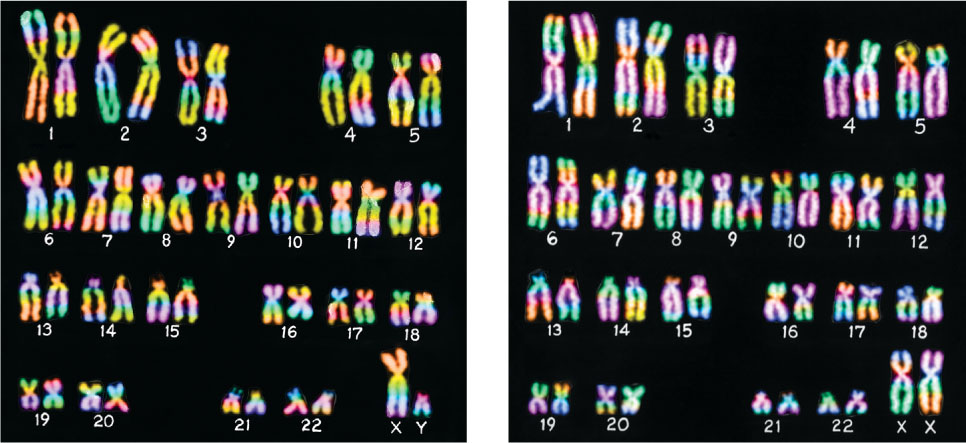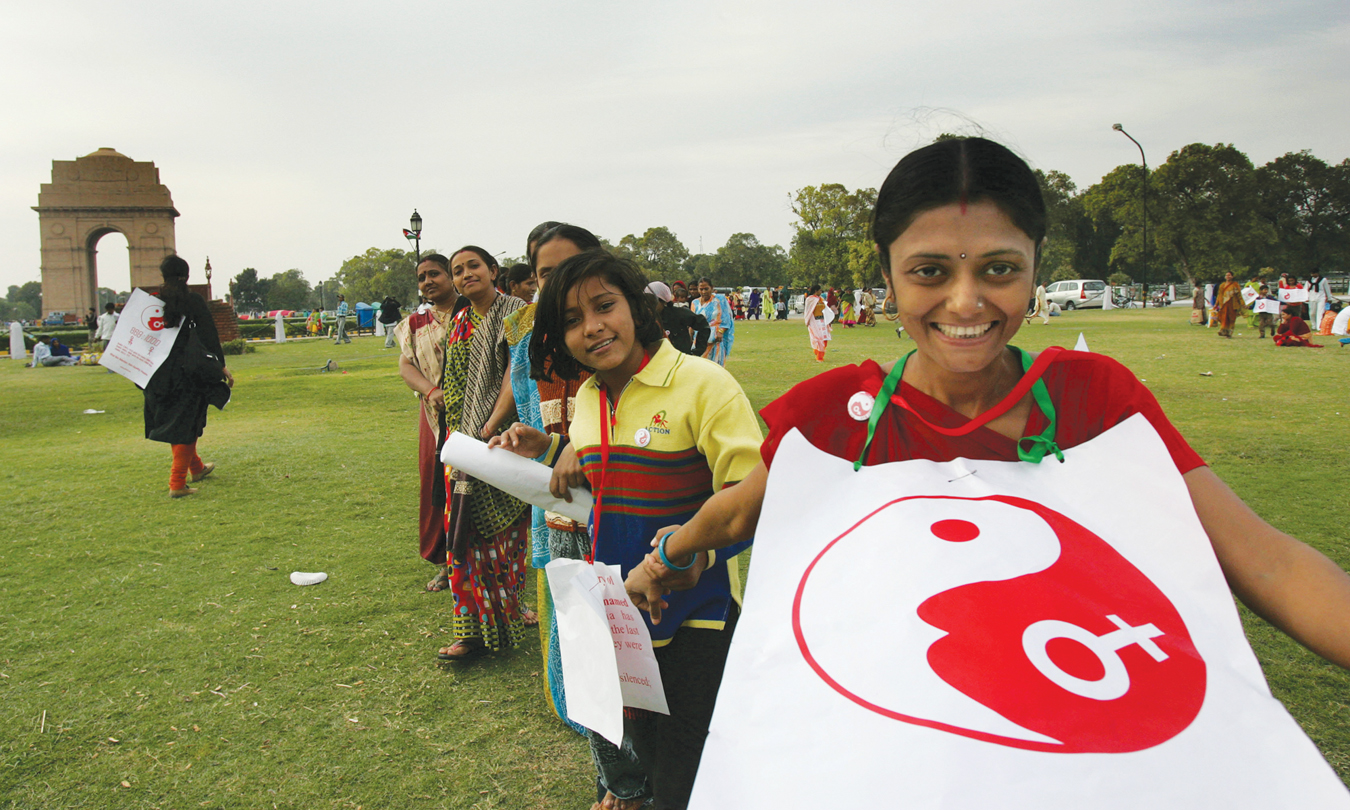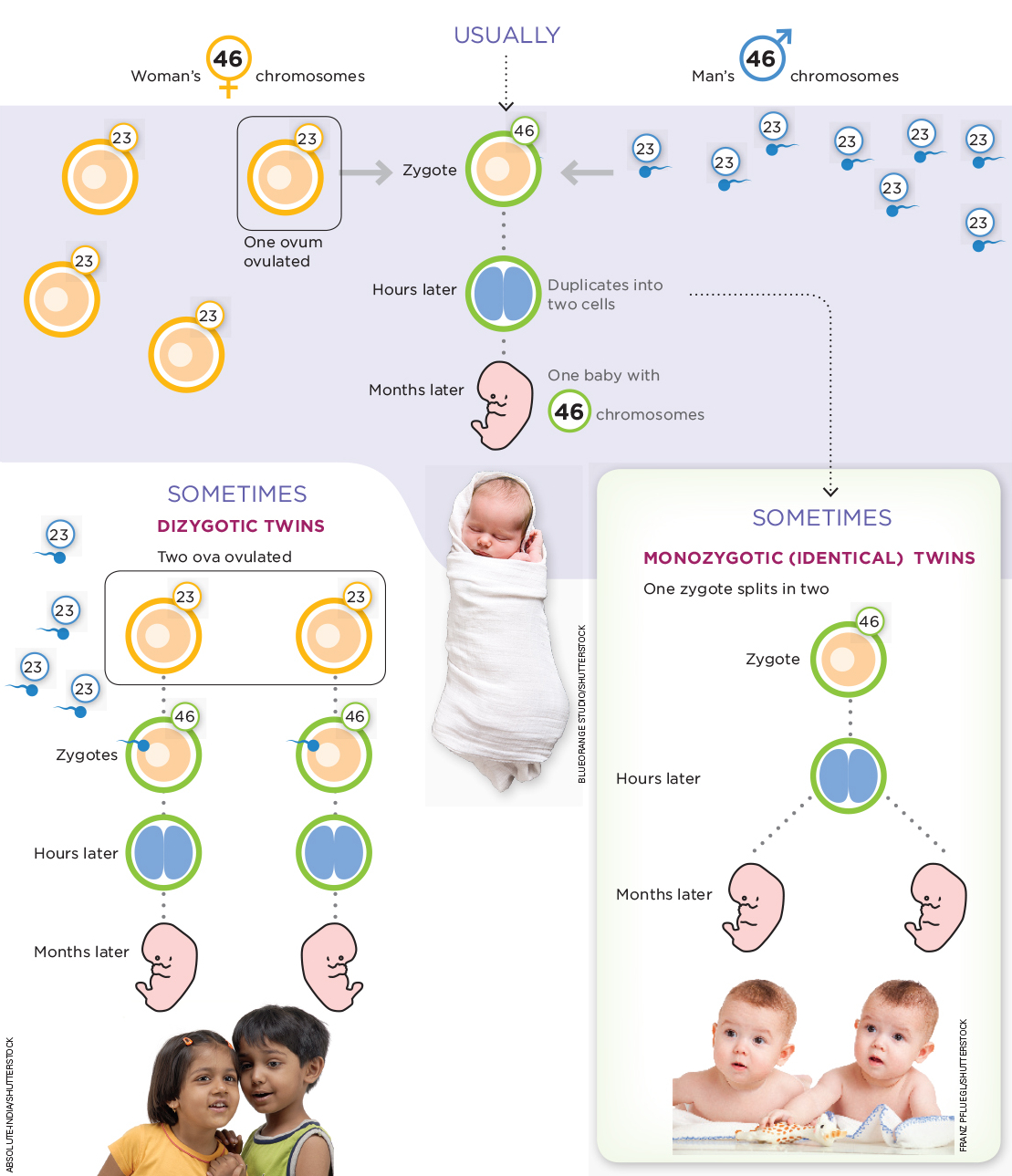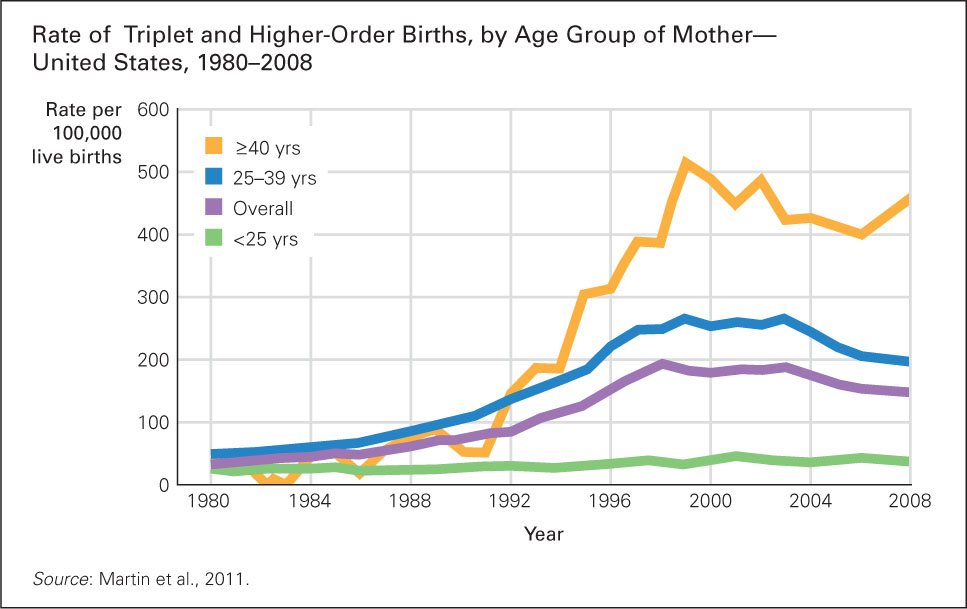 The Beginnings of Life
The Beginnings of Life
The one-celled zygote copies itself again and again, changing names as it multiplies—from morula to blastocyst, from embryo to fetus—and finally, at birth, baby. [Lifespan Link: Prenatal growth is described in Chapter 4.] By adulthood, a person has between 50 trillion and 100 trillion cells, each with the same 46 chromosomes and the same thousands of genes of the original zygote.
The particular member of each chromosome pair from each parent on a given gamete is randomly selected. A man or woman can produce 223 different gametes—more than 8 million versions of his or her own 46 chromosomes. If a given couple conceived a billion zygotes, each would be genetically unique because of the chromosomes of the particular sperm that fertilized that particular ovum. Interacting alleles, methylation, and other genetic forces add more variations to the zygote. Epigenetics silence some genes and increase others. Nurture creates even more variations.
Matching Genes
genotype An organism’s entire genetic inheritance, or genetic potential.
The genes on the chromosomes constitute the organism’s genetic inheritance, or genotype, which endures throughout life. Growth requires duplication again and again of the code of the original cell.
homozygous Referring to two genes of one pair that are exactly the same in every letter of their code. Most gene pairs are homozygous.
In 22 of the 23 pairs of chromosomes, both members of the pair are closely matched. Each of these 44 chromosomes is called an autosome, which means that it is independent (auto means “self”) of the sex chromosomes (the 23rd pair). Each autosome, from number 1 to number 22, contains hundreds of genes in the same positions and sequence. If the code of the gene from one parent is exactly like the code on the same gene from the other parent, the gene pair is homozygous (literally, “same-zygote”).
heterozygous Referring to two genes of one pair that differ in some way. Typically one allele has only a few base pairs that differ from the other member of the pair.
The match is not always letter perfect because the mother might have a different allele for a particular gene than the father has. If a gene’s code differs from that of its counterpart, the two genes still pair up, but the zygote (and, later, the person) is heterozygous. This can occur with any of the gene pairs, but the most dramatic example of a heterozygous pairing is chromosomal, not genetic, with the 23rd pair.
Male or Female?
23rd pair The chromosome pair that, in humans, determines sex. The other 22 pairs are autosomes, inherited equally by males and females.
XX A 23rd chromosome pair that consists of two X-shaped chromosomes, one each from the mother and the father. XX zygotes become females.
XY A 23rd chromosome pair that consists of an X-shaped chromosome from the mother and a Y-shaped chromosome from the father. XY zygotes become males.
The chromosomes that make up the 23rd pair are the sex chromosomes. In females, the 23rd pair is composed of two X-shaped chromosomes. Accordingly, it is called XX. In males, the 23rd pair has one X-shaped chromosome and one Y-shaped chromosome. It is called XY.

Because a female’s 23rd pair is XX, all her ova contain either one X or the other—but always an X. And because a male’s 23rd pair is XY, half of his sperm carry an X chromosome and half a Y. The X chromosome is bigger and has more genes, but the Y chromosome has a crucial gene, called SRY, that directs the embryo to make male hormones and organs. Thus, sex depends on which sperm penetrates the ovum—a Y sperm with the SRY gene, creating a boy (XY), or an X sperm, creating a girl (XX) (see Figure 3.2).

FIGURE 3.2
One Species, a Billion Variations Dogs immediately recognize other dogs, even from a distance, despite dramatic differences in size, shape, coloring (of tongues and eyes as well as coats), and, as shown here, in hair. Minor code variations become marked fur differences—long or short, curly or straight, wiry or limp.GETTY IMAGES/HEMERA/THINKSTOCK (Bottom left)
PHOTODISC (Top right)
PHOTODISC (Bottom right)
In some other species, sex is not determined at conception. In certain reptiles, for instance, temperature during incubation of the fertilized egg affects the sex of the embryo (Hare & Cree, 2010). However, for humans, the zygote is either XX or XY, a fact that in the past was not revealed to anyone until the baby was born. Today sex can be known much earlier: Parents choose names, decorate nurseries, and bond with the future boy or girl—or not, as the opposing perspective explains.
New Cells, New Functions
Within hours after conception, the zygote begins duplication and division. First, the 23 pairs of chromosomes carrying all the genes duplicate, forming two complete sets of the genome. These two sets move toward opposite sides of the zygote, and the single cell splits neatly down the middle into two cells, each containing the original genetic code. These two cells duplicate and divide, becoming four, which duplicate and divide, becoming eight, and so on.
OPPOSING PERSPECTIVES
Too Many Boys?
Parents can choose to give birth to only boys or only girls; millions of couples have done it. Is this a problem?
Historically, in every culture, some newborns were killed because they were female. One of the moral advances of Islam, founded in the seventh century, was to forbid female infanticide. Currently, the birth of a child of unwanted sex can be prevented long before birth in three ways: by inactivating X or Y sperm before conception; by inserting only the male or female zygotes after in vitro conception; or by aborting XX or XY fetuses. Should that be now banned as immoral?

In China, a “one-child” policy implemented in about 1979 cut the birth rate in half. That achieved the intended goal: Severe poverty was almost eliminated. Unanticipated results included (1) increased abortions of female fetuses, (2) millions of newborn girls available for adoption, and, recently, (3) far more unmarried young men than women. In 1993, the Chinese government forbade prenatal testing for sex selection; in 2013, China rescinded the one-child policy.
That policy change may be too late. Routine sonograms reveal sex, and the sex ratio of newborns in many regions of Asia (not only in China) is as high as four boys born for every three girls. One elderly Indian man said, “We should have at least four children per family, three of them boys” (quoted in Khanna, 2010, p. 66). The preference for boys occurs partly because in many East Asian cultures, sons are expected to care for their aged parents. Thus parents want to have a boy.

Couples of Asian ancestry in the United States also prefer boys (Puri et al., 2011). In some Western nations, including Germany, girls are preferred—both as newborns and as caregivers of the old (Wilhelm et al., 2013).
The most common argument in favor of sex selection is freedom to choose. Some fertility doctors and parents believe that sex selection is a reproductive right and that couples should be able to decide to have either a boy or a girl (Puri & Nachtigall, 2009). Some people who themselves would not abort a fetus nonetheless favor allowing personal freedom—in this case, freedom to “balance” the family.
Why would anyone object to freedom? The Chinese experience shows that sex selection can have unanticipated consequences. For instance, now many more young Chinese men than women die prematurely. The developmental explanation is that unmarried young men in every culture take risks to attract women and become depressed if they remain single.
Other problems may occur: Males are more likely to be learning disabled, drug addicted, and criminal, as well as to start wars and suffer heart attacks. Any nation with more men than women will risk increases in all these problems.
But wait: Chromosomes and genes do not determine behavior. Every sex difference is a product of culture. Even traits that originate with biology, such as the propensity to heart attacks, are affected more by environment (in this case, diet and cigarettes) than by XX or XY chromosomes. Perhaps nurture could change if nature produced more males than females, and then societies would not suffer. The frequency of sex selection is influenced by national policy and cultural values (Park et al., 2012).
Might laws against prenatal sex choices be unnecessary if culture could shift? “Might” … “if” … Critical thinking needed.
Every Cell the Same
By the time a baby is born, the zygote has become about 5 trillion cells, all influenced by material surrounding the genes (once called junk DNA) and by whatever nutrients, drugs, hormones, viruses, and so on came to the embryo from the pregnant woman. Almost every human cell carries a complete copy of the genetic instructions of the one-celled zygote. This explains why DNA testing of any body cell, even from a drop of blood or a snip of hair, can identify “the real father,” “the guilty criminal,” “the long-lost brother.”
DNA lingers long after death. This fact is evident in living African Americans who claimed Thomas Jefferson as an ancestor: DNA testing proved some of them right and some of them wrong (Foster et al., 1998).
Indeed, because the Y chromosome is passed down to every male descendant, and because the genes on the Y typically do not change from one generation to another, men have the Y of one of their male ancestors who died thousands of years ago. Tracing that Y chromosome suggests that thousands of East Asian men may be descendants of Genghis Khan—although that twelfth-century leader’s bones and thus his DNA have never been found (Stoneking & Delfin, 2010). Such genetic sleuthing is not totally reliable: It is quite possible to trace ancestry for several generations; it is much more complex to go back for hundreds of years.
Stem Cells
stem cells Cells from which any other specialized type of cell can form.
The cells that result from the early duplication and division are called stem cells; these cells are able to produce any other cell and thus to become a complete person. Indeed, as later described, sometimes those cells split apart and each becomes an identical twin.
After about the eight-cell stage, although duplication and division continue, a third process, differentiation, begins. In differentiation, cells specialize, taking different forms and reproducing at various rates depending on where they are located. For instance, some cells become part of an eye, others part of a finger, still others part of the brain. They are no longer stem cells. Blood cells in the umbilical cord, however, may act like stem cells.
Scientists have discovered ways to add genes to certain differentiated cells in a laboratory process that reprograms those cells, making them like stem cells again. However, scientists do not yet know how to use reprogrammed stem cells to cure genetic conditions without harming other cells. One use of reprogrammed cells has been found: to test drugs to treat diseases caused by genes, either directly (such as sickle-cell anemia) or indirectly (such as heart disease, diabetes, and dementia) (Zhu & Huangfu, 2013; Vogel, 2010).
Some U.S. restrictions on stem cell research were lifted in 2009, and some states (e.g., California) and nations (e.g., South Korea) allow more extensive research, but everywhere many ethical and practical issues remain (Nguyen et al., 2013). As the head of the Michael J. Fox Foundation for Parkinson’s Research said, “All my exposure was pop media. I thought it was all about stem cells. I have not totally lost hope on cell replacement, I just don’t think it’s a near-term hope” (Hood, quoted in Holden, 2009).
Twins
One “near-term hope” four decades ago has become reality, beginning with the birth of Louise Brown in England in 1978. Millions of infertile couples now have babies, often twins, increasing the demand for twin strollers and rhyming names—and also increasing the number of tiny, preterm newborns fighting for life in hospital intensive-care nurseries. Such multiple births from more than one ovum and sperm are usually the result of fertilization outside the mother’s body. To understand twin conceptions, you need to know the difference between mono-zygotic and dizygotic twins (see Visualizing Development 3, p. 74).
Monozygotic Twins
Although every zygote is genetically unique, about once in 250 human conceptions, duplication results in one or more complete splits, creating two, or four, or even eight separate zygotes, each identical to the first single cell. This kind of split is illegal for humans in a laboratory, but nature does it occasionally in the womb. (An incomplete split creates conjoined twins, formerly called Siamese twins.)
monozygotic (MZ) twins Twins who originate from one zygote that splits apart very early in development. (Also called identical twins.) Other monozygotic multiple births (such as triplets and quadruplets) can occur as well.
If each of those separated cells from one zygote then duplicates, divides, differentiates, implants, grows, and survives, multiple births occur. One separation results in monozygotic (MZ) twins, from one (mono) zygote (also called identical twins). Two or three separations create monozygotic quadruplets or octuplets. Because monozygotic multiples originate from the same zygote, they have identical genetic instructions for appearance, psychological traits, disease vulnerability, and everything else genetic.
VISUALIZING DEVELOPMENT
One Baby or More
Humans usually have one baby at a time, but sometimes twins are born. Most often they are from two ova fertilized by two sperm (lower left), resulting in dizygotic twins. Sometimes, however, one zygote splits in two (lower right), resulting in mono-zygotic twins; if each of these zygotes splits again, the result is monozygotic quadruplets.

Monozygotic twins are blessed in some ways: they can donate a kidney or other organ to their twin with no organ rejection, thus avoiding the major complication with surgical transplants. On a lighter note, they can also befuddle their parents and teachers, who may use special signs (such as different earrings) to tell them apart. Usually, the twins themselves find their own identities while enjoying twin-ship. They might enjoy inherited athletic ability, for instance, with one playing basketball and the other soccer.
As one monozygotic twin writes:
Twins put into high relief the central challenge for all of us: self-definition. How do we each plant our stake in the ground, decide how sensitive, callous, ambitious, cautious, or conciliatory we want to be every day? … Twins come with a built-in constant comparison, but defining oneself against one’s twin is just an amped-up version of every person’s life-long challenge: to individuate, to create a distinctive persona in the world.
[Pogrebin, 2010, p. 9]
Dizygotic Twins
dizygotic (DZ) twins Twins who are formed when two separate ova are fertilized by two separate sperm at roughly the same time. (Also called fraternal twins.)
Among naturally-conceived twins, only about one in three pairs is monozygotic. Most are dizygotic (DZ), also called fraternal twins. They began life as two separate zygotes created by two ova fertilized by two sperm at the same time. (Usually, women release only one ovum per month, but sometimes double or triple ovulation occurs, a tendency that is affected by genes.) Note that dizygotic twinning depends on multiple ovulation, so the likelihood of a woman bearing twins depends on her genes, not the father’s. However, a man has half his genes from his mother. If multiple ovulation is in his family, he will not produce twins, but his daughters might.
When dizygotic twinning occurs naturally, the incidence varies by ethnicity. For example, about 1 in 11 Yorubas in Nigeria is a twin, as are about 1 in 45 European Americans, 1 in 75 Japanese and Koreans, and 1 in 150 Chinese. Age matters, too: Older women more often double-ovulate and thus have more twins. After twins are conceived, their chance of survival until birth depends on the prenatal circumstances: An early sonogram might reveal two developing organisms, but later only one embryo continues to grow. This vanishing twin phenomenon may occur in about 12 percent of pregnancies (Giuffrè et al., 2012).
Like all full siblings, DZ twins have about half of their genes in common. They can differ markedly in appearance, or they can look so much alike that only genetic tests can determine whether they are monozygotic or dizygotic. Chance determines which sperm fertilizes each ovum, so about half are same-sex pairs and half are boy–
Assisted Reproduction
assisted reproductive technology (ART) A general term for the techniques designed to help infertile couples conceive and then sustain a pregnancy.
in vitro fertilization (IVF) Fertilization that takes place outside a woman’s body (as in a glass laboratory dish). The procedure involves mixing sperm with ova that have been surgically removed from the woman’s ovary. If a zygote is produced, it is inserted into a woman’s uterus, where it may implant and develop into a baby.
When couples are infertile (a condition affecting about 12 percent of U.S. couples), they have many choices. [Lifespan Link: Causes and choices of infertility are discussed in Chapter 20.] To better understand conception, one choice is explained here, assisted reproductive technology (ART). A woman can take drugs to cause ovulation, often of several ova, which may lead to multiple births (see Figure 3.3). Or ova can be surgically removed from an ovary, fertilized in a lab dish, and then inserted into the uterus. This procedure is known as in vitro fertilization (IVF)—in vitro means “in glass.” Younger women are more likely to have successful IVF pregnancies, but even among healthy young women, less than half of IVF cycles result in a baby.

FIGURE 3.3
Why More Multiple Births? Historically in the United States, the natural rate of multiple births tended to increase as mothers aged. Women in their mid to late 30s were more likely to have twins or triplets than those who were younger. The advent of assisted reproductive technology (ART) led to a dramatic increase in multiple births overall starting in the early 1990s; it is now women aged 40 and over who are most likely to experience this phenomenon. After peaking in the late 1990s, rates of triplet births declined, as the hazards of multiple births are more apparent.intra-cytoplasmic injection (ICSI) An in vitro fertilization technique in which a single sperm cell is injected directly into an ovum.
In IVF a sperm often is inserted directly into each ovum to improve the odds of fertilization, in a procedure called intra-cytoplasmic sperm injection (ICSI). Zygotes that fail to duplicate, or blastocysts tested positive for serious genetic diseases, are rejected. Then, after two to six days of development outside the uterus, technicians insert the normally developing cells, either one blastocyst or several, into the uterus. Between 1 and 3 percent of all newborns in developed nations and thousands more in developing nations are the result of IVF.
ART has enabled millions of couples to have children. Indeed, some parents have children who are not genetically or biologically theirs if others donate the sperm, the ova, and/or the womb (Almeling, 2011). The word donate may be misleading, since people—often college students—are paid for their sperm, ova, or pregnancy. Most people who become parents via IVF are heterosexual, with one partner infertile, but a sizable minority are same-sex couples.
Although donors are screened for serious genetic problems, birth defects and later illnesses increase slightly with IVF. The risk is small: About 97 percent of all IVF newborns have no apparent defects. Not small, however, is the risk of prematurity and low birthweight. [Lifespan Link: The problems of low birthweight are discussed in Chapter 4.] In the United States, almost half of all IVF babies are twins or triplets (MMWR, November 2, 2012).
Most European nations limit the numbers of blastocysts inserted into the uterus at one time, partly because national health care pays for both IVF and newborn care. If only one blastocyst is inserted, others are usually frozen for later insertion if the first one does not develop. According to research in seven nations, inserting just one blastocyst results in as many successful pregnancies as inserting multiple blastocysts, but fewer low-birthweight newborns (7 percent compared to 30 percent), primarily because each fetus develops alone (Grady et al., 2012).
SUMMING UP
People usually have 23 chromosomes from their mother and 23 from their father, with all the genes and chromosomes matched up into mother–
Twins are monozygotic (one zygote, from the same stem cells) or dizygotic (two zygotes). Assisted reproductive technology has increased the rate of multiple births. Modern reproductive measures, including IVF, have led to millions of much-wanted, healthy infants but also to new dilemmas, including whether people should be able to choose the sex, the genetic and biological parentage, and the number of newborns they have.